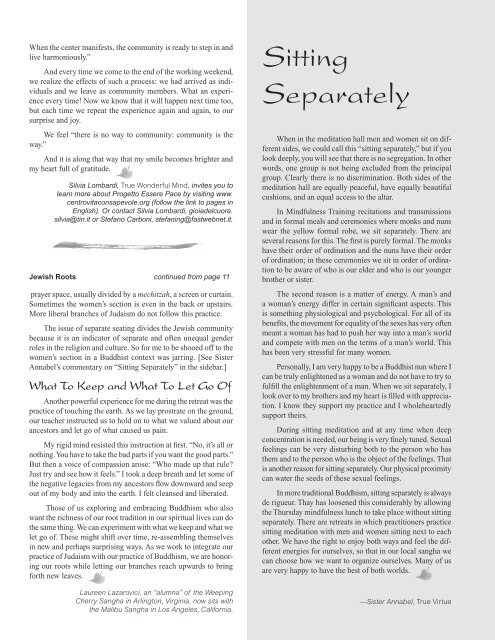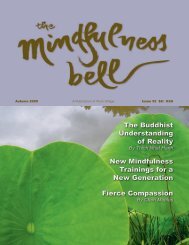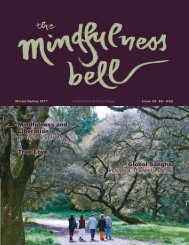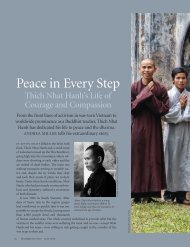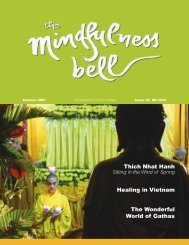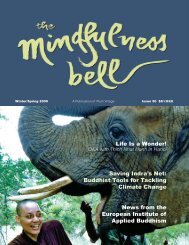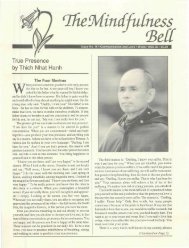Thich Nhat Hanh Jewish Roots The Better Way to Live Alone in the ...
Thich Nhat Hanh Jewish Roots The Better Way to Live Alone in the ...
Thich Nhat Hanh Jewish Roots The Better Way to Live Alone in the ...
- No tags were found...
You also want an ePaper? Increase the reach of your titles
YUMPU automatically turns print PDFs into web optimized ePapers that Google loves.
sangha NEWSWhen <strong>the</strong> center manifests, <strong>the</strong> community is ready <strong>to</strong> step <strong>in</strong> andlive harmoniously.”And every time we come <strong>to</strong> <strong>the</strong> end of <strong>the</strong> work<strong>in</strong>g weekend,we realize <strong>the</strong> effects of such a process: we had arrived as <strong>in</strong>dividualsand we leave as community members. What an experienceevery time! Now we know that it will happen next time <strong>to</strong>o,but each time we repeat <strong>the</strong> experience aga<strong>in</strong> and aga<strong>in</strong>, <strong>to</strong> oursurprise and joy.We feel “<strong>the</strong>re is no way <strong>to</strong> community: community is <strong>the</strong>way.”And it is along that way that my smile becomes brighter andmy heart full of gratitude.Silvia Lombardi, True Wonderful M<strong>in</strong>d, <strong>in</strong>vites you <strong>to</strong>learn more about Proget<strong>to</strong> Essere Pace by visit<strong>in</strong>g www.centrovitaconsapevole.org (follow <strong>the</strong> l<strong>in</strong>k <strong>to</strong> pages <strong>in</strong>English). Or contact Silvia Lombardi, gioiadelcuore.silvia@t<strong>in</strong>.it or Stefano Carboni, stefan<strong>in</strong>g@fastwebnet.it.<strong>Jewish</strong> <strong>Roots</strong> cont<strong>in</strong>ued from page 11prayer space, usually divided by a mechitzah, a screen or curta<strong>in</strong>.Sometimes <strong>the</strong> women’s section is even <strong>in</strong> <strong>the</strong> back or upstairs.More liberal branches of Judaism do not follow this practice.<strong>The</strong> issue of separate seat<strong>in</strong>g divides <strong>the</strong> <strong>Jewish</strong> communitybecause it is an <strong>in</strong>dica<strong>to</strong>r of separate and often unequal genderroles <strong>in</strong> <strong>the</strong> religion and culture. So for me <strong>to</strong> be shooed off <strong>to</strong> <strong>the</strong>women’s section <strong>in</strong> a Buddhist context was jarr<strong>in</strong>g. [See SisterAnnabel’s commentary on “Sitt<strong>in</strong>g Separately” <strong>in</strong> <strong>the</strong> sidebar.]What To Keep and What To Let Go OfAno<strong>the</strong>r powerful experience for me dur<strong>in</strong>g <strong>the</strong> retreat was <strong>the</strong>practice of <strong>to</strong>uch<strong>in</strong>g <strong>the</strong> earth. As we lay prostrate on <strong>the</strong> ground,our teacher <strong>in</strong>structed us <strong>to</strong> hold on <strong>to</strong> what we valued about ourances<strong>to</strong>rs and let go of what caused us pa<strong>in</strong>.My rigid m<strong>in</strong>d resisted this <strong>in</strong>struction at first. “No, it’s all ornoth<strong>in</strong>g. You have <strong>to</strong> take <strong>the</strong> bad parts if you want <strong>the</strong> good parts.”But <strong>the</strong>n a voice of compassion arose: “Who made up that rule?Just try and see how it feels.” I <strong>to</strong>ok a deep breath and let some of<strong>the</strong> negative legacies from my ances<strong>to</strong>rs flow downward and seepout of my body and <strong>in</strong><strong>to</strong> <strong>the</strong> earth. I felt cleansed and liberated.Those of us explor<strong>in</strong>g and embrac<strong>in</strong>g Buddhism who alsowant <strong>the</strong> richness of our root tradition <strong>in</strong> our spiritual lives can do<strong>the</strong> same th<strong>in</strong>g. We can experiment with what we keep and what welet go of. <strong>The</strong>se might shift over time, re-assembl<strong>in</strong>g <strong>the</strong>mselves<strong>in</strong> new and perhaps surpris<strong>in</strong>g ways. As we work <strong>to</strong> <strong>in</strong>tegrate ourpractice of Judaism with our practice of Buddhism, we are honor<strong>in</strong>gour roots while lett<strong>in</strong>g our branches reach upwards <strong>to</strong> br<strong>in</strong>gforth new leaves.Laureen Lazarovici, an “alumna” of <strong>the</strong> Weep<strong>in</strong>gCherry Sangha <strong>in</strong> Arl<strong>in</strong>g<strong>to</strong>n, Virg<strong>in</strong>ia, now sits with<strong>the</strong> Malibu Sangha <strong>in</strong> Los Angeles, California.Sitt<strong>in</strong>gSeparatelyWhen <strong>in</strong> <strong>the</strong> meditation hall men and women sit on differentsides, we could call this “sitt<strong>in</strong>g separately,” but if youlook deeply, you will see that <strong>the</strong>re is no segregation. In o<strong>the</strong>rwords, one group is not be<strong>in</strong>g excluded from <strong>the</strong> pr<strong>in</strong>cipalgroup. Clearly <strong>the</strong>re is no discrim<strong>in</strong>ation. Both sides of <strong>the</strong>meditation hall are equally peaceful, have equally beautifulcushions, and an equal access <strong>to</strong> <strong>the</strong> altar.In M<strong>in</strong>dfulness Tra<strong>in</strong><strong>in</strong>g recitations and transmissionsand <strong>in</strong> formal meals and ceremonies where monks and nunswear <strong>the</strong> yellow formal robe, we sit separately. <strong>The</strong>re areseveral reasons for this. <strong>The</strong> first is purely formal. <strong>The</strong> monkshave <strong>the</strong>ir order of ord<strong>in</strong>ation and <strong>the</strong> nuns have <strong>the</strong>ir orderof ord<strong>in</strong>ation; <strong>in</strong> <strong>the</strong>se ceremonies we sit <strong>in</strong> order of ord<strong>in</strong>ation<strong>to</strong> be aware of who is our elder and who is our youngerbro<strong>the</strong>r or sister.<strong>The</strong> second reason is a matter of energy. A man’s anda woman’s energy differ <strong>in</strong> certa<strong>in</strong> significant aspects. Thisis someth<strong>in</strong>g physiological and psychological. For all of itsbenefits, <strong>the</strong> movement for equality of <strong>the</strong> sexes has very oftenmeant a woman has had <strong>to</strong> push her way <strong>in</strong><strong>to</strong> a man’s worldand compete with men on <strong>the</strong> terms of a man’s world. Thishas been very stressful for many women.Personally, I am very happy <strong>to</strong> be a Buddhist nun where Ican be truly enlightened as a woman and do not have <strong>to</strong> try <strong>to</strong>fulfill <strong>the</strong> enlightenment of a man. When we sit separately, Ilook over <strong>to</strong> my bro<strong>the</strong>rs and my heart is filled with appreciation.I know <strong>the</strong>y support my practice and I wholeheartedlysupport <strong>the</strong>irs.Dur<strong>in</strong>g sitt<strong>in</strong>g meditation and at any time when deepconcentration is needed, our be<strong>in</strong>g is very f<strong>in</strong>ely tuned. Sexualfeel<strong>in</strong>gs can be very disturb<strong>in</strong>g both <strong>to</strong> <strong>the</strong> person who has<strong>the</strong>m and <strong>to</strong> <strong>the</strong> person who is <strong>the</strong> object of <strong>the</strong> feel<strong>in</strong>gs. Thatis ano<strong>the</strong>r reason for sitt<strong>in</strong>g separately. Our physical proximitycan water <strong>the</strong> seeds of <strong>the</strong>se sexual feel<strong>in</strong>gs.In more traditional Buddhism, sitt<strong>in</strong>g separately is alwaysde rigueur. Thay has loosened this considerably by allow<strong>in</strong>g<strong>the</strong> Thursday m<strong>in</strong>dfulness lunch <strong>to</strong> take place without sitt<strong>in</strong>gseparately. <strong>The</strong>re are retreats <strong>in</strong> which practitioners practicesitt<strong>in</strong>g meditation with men and women sitt<strong>in</strong>g next <strong>to</strong> eacho<strong>the</strong>r. We have <strong>the</strong> right <strong>to</strong> enjoy both ways and feel <strong>the</strong> differentenergies for ourselves, so that <strong>in</strong> our local sangha wecan choose how we want <strong>to</strong> organize ourselves. Many of usare very happy <strong>to</strong> have <strong>the</strong> best of both worlds.—Sister Annabel, True Virtue<strong>the</strong> M<strong>in</strong>dfulness Bell 43


